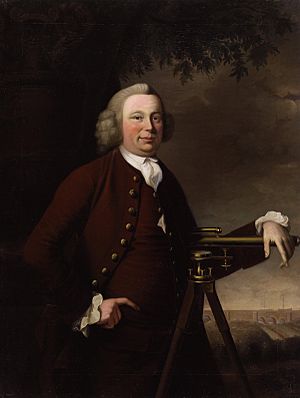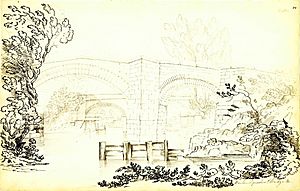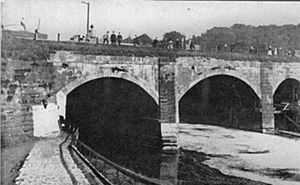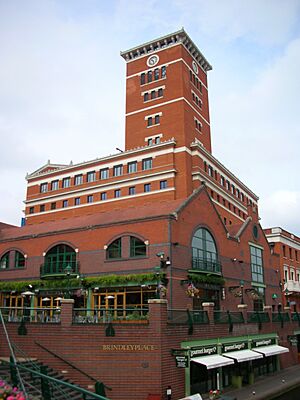James Brindley facts for kids
James Brindley (born 1716 – died 27 September 1772) was an amazing English engineer. He was born in Tunstead, Derbyshire, and spent much of his life in Leek, Staffordshire. He became one of the most important engineers of the 1700s.
Contents
Early Life of James Brindley
James Brindley grew up in the Peak District, a very isolated area back then. His family were well-off farmers and craftspeople. He didn't go to a regular school, but his mother taught him at home.
When he was 17, his mother encouraged him to become an apprentice to a millwright (someone who builds and repairs mills) in Sutton, Macclesfield. James quickly showed incredible talent and skill. After his training, he started his own business as a wheelwright in Leek.
In 1750, he expanded his business. He rented a millwright's shop in Burslem from the Wedgwood family. They became his close friends for life. James soon became known for being clever and skilled at fixing all sorts of machines. In 1752, he designed a special engine to drain water from a coal mine called the Wet Earth Colliery in Clifton. Three years later, he built a machine for a silk factory in Congleton.
Building Early Canals
James Brindley's great reputation caught the attention of the 3rd Duke of Bridgewater. The Duke needed a better way to move coal from his mines in Worsley to Manchester.
In 1759, the Duke hired Brindley to build a canal for this purpose. The Bridgewater Canal opened in 1761. Many people see it as the first modern British canal. It was a huge success in engineering. Brindley was hired as the main consulting engineer.
While Brindley is often praised for this canal, it's now thought that the Duke himself and his agent, John Gilbert, were the main designers. Brindley was brought in to help with specific challenges. One big challenge was the Barton Aqueduct. This amazing part of the canal carried the waterway 12 metres (39 feet) high over the River Irwell at Barton.
Brindley's Canal Building Techniques
Brindley had a clever way of building canals that saved a lot of digging. He used a method called "contouring." This meant he would make the canal follow the natural shape of the land. He preferred longer, winding routes that avoided building tall embankments or deep cuttings. He also liked to use tunnels instead of digging through hills. This was smart because digging was very difficult back then.
His biggest contribution was a technique called puddling clay. This involved using special clay to make the canal walls watertight. This "puddle clay" was used a lot in building canals across the UK. Later, it was also used to create the waterproof core inside large earth dams, especially in the Pennines.
Becoming a Master Canal Engineer
Brindley's fame grew quickly, and soon he was asked to build many more canals. He extended the Bridgewater Canal to Runcorn. This connected it to his next major project, the Trent and Mersey Canal.
At this time, Brindley had never built a canal lock. So, he built a test lock in his garden at Turnhurst. This test helped him design the narrow canal lock that became common in the Midlands. These locks were made for long, thin boats called "starvationers," which later became known as narrowboats. This design choice shaped the future of the English canal system.
Brindley had a big dream: to connect England's four great rivers. These were the Mersey, Trent, Severn, and Thames. He called this the "Grand Cross" scheme. In 1762, he started surveying for this huge project.
The pottery makers around Stoke-on-Trent desperately needed a better way to move their fragile goods. They strongly supported connecting Staffordshire to the Trent and Mersey rivers. The first shovel of earth for the Trent and Mersey Canal was dug by Josiah Wedgwood in 1766.
From Runcorn, the canal would climb using 35 locks. It would then pass through a very long tunnel, the Harecastle Tunnel, which was 3,000 yards (about 2.7 km) long. After the tunnel, it would go down 40 more locks to join the Trent River near Shardlow. Many people made fun of his ambitious plan. The canal opened from Shardlow to near Stafford in 1770, but the tunnel took 11 years to finish!
The Trent and Mersey Canal was the first part of Brindley's huge network. He saw it as the "Grand Trunk Canal" or the "Grand Cross" of waterways across the country. However, he didn't live to see his entire vision completed. The Harecastle Tunnel finally opened in 1777. Coal was transported from the Midlands to the Thames at Oxford in January 1790, 18 years after Brindley's death. Other engineers, like Thomas Telford, had to finish building the network.
Throughout his life, James Brindley built an amazing 365 miles (587 km) of canals. He also built many watermills, including the Staffordshire and Worcestershire Canal, the Coventry Canal, and the Oxford Canal. He also constructed the watermill at Leek, which is now the Brindley Water Museum.
James Brindley's Last Years
James Brindley was so focused on his work that he didn't have time for common fun activities. When he faced a difficult problem, he would often go to bed. He would lie there for one, two, or even three days, thinking about the problem until he found a solution.
... so occupied was his mind with his business, that he was incapable of relaxing in any of the common amusements of life. As he had not the ideas of other men to assist him, whenever a point of difficulty in contrivance occurred, it was his custom to retire to his bed, where in perfect solitude he would lie for one, two, or three days, pondering the matter in his mind, till the requisite expedient had presented itself.
Brindley married Anne Henshall on 8 December 1765. He was 49, and she was 19. Anne's brother, Hugh Henshall, also worked on canal construction. James and Anne had two daughters, Anne and Susannah.
In 1771, work started on the Chesterfield Canal. While surveying a new part of the Trent and Mersey Canal, Brindley got caught in a heavy rainstorm. This had happened before, but he couldn't dry off properly at the inn where he was staying. He caught a bad chill and became very ill. He returned home to Turnhurst, Staffordshire. Doctor Erasmus Darwin visited him and found that he had diabetes.
James Brindley died at Turnhurst on 27 September 1772. He was buried on 30 September at St. James in Newchapel. This was just nine days after his Birmingham Canal was finished. A plaque at the church says he died on 25 September. His grave says: "James Brindley, of Turnhurst, engineer, was interred 30 September 1772, aged 56."
Brindley's wife remarried in 1775 to Robert Williamson, one of Brindley's assistants. She lived until 1799.
Remembering James Brindley
The Chester Courant newspaper wrote a poem about Brindley after he died:
JAMES BRINDLEY lies amongst these Rocks,
He made Canals, Bridges, and Locks,
To convey Water; he made Tunnels
For Barges, Boats, and Air-Vessels;
He erected several Banks,
Mills, Pumps, Machines, with Wheels and Cranks;
He was famous t'invent Engines,
Calculated for working Mines;
He knew Water, its Weight and Strength,
Turn'd Brooks, made Soughs to a great Length;
While he used the Miners' Blast,
He stopp'd Currents from running too fast;
There ne'er was paid such Attention
As he did to Navigation.
But while busy with Pit or Well,
His Spirits sunk below Level;
And, when too late, his Doctor found,
Water sent him to the Ground.
James Brindley is remembered in many places. In Birmingham, there's Brindley Drive, the Brindleyplace area, and a pub called The James Brindley. There's also the James Brindley School for children in Birmingham's hospitals. In Leek, you can visit the James Brindley Mill. Many streets in areas where he worked are named after him.
There are also statues of him. One is in Coventry, showing him leaning over his desk. Another is in Etruria, Stoke-on-Trent, where the Trent and Mersey Canal meets the Caldon Canal. In Runcorn, the Brindley Arts Centre is named after him. There's also the James Brindley Science College in Chell, Stoke-on-Trent, and the Brindley's Lock pub.
The well in the village of Wormhill is dedicated to Brindley. Wormhill is in the same area as Tunstead, where he was born.
See also
- History of the British canal system
- Waterways in the United Kingdom
- List of civil engineers







